人力与组织管理1.define the term organisation
人力资源管理与组织行为

人力资源管理与组织行为人力资源管理(HRM)是指组织中负责管理与协调员工和人力资本的活动。
而组织行为(OB)是研究个体、团队和组织如何影响、被影响以及如何适应变化的学科。
本文将探讨人力资源管理与组织行为之间的关系,以及人力资源管理如何影响组织行为的方方面面。
1. 人力资源管理的核心功能1.1 职位招募与选择职位招募与选择是人力资源管理的重要环节,它涉及到确定组织需求、招募途径、招募渠道、面试与考核等。
合适的招募与选择过程能够帮助组织筛选出具备相关能力和价值观的员工,从而提高组织绩效。
1.2 员工培训与发展员工培训与发展是组织中不可或缺的环节。
通过培训与发展,员工能够不断提升自身能力,适应组织变化,并为组织的可持续发展做出贡献。
1.3 绩效管理绩效管理是评估员工工作表现,为员工提供反馈意见,并制定激励措施的过程。
通过绩效管理,组织能够激励员工持续提高工作绩效,并促进组织的整体发展。
1.4 员工关系管理员工关系管理涉及处理员工与管理层之间的关系以及员工之间的关系。
良好的员工关系能够提高员工满意度和工作效率,增强组织的凝聚力。
2. 人力资源管理对组织行为的影响2.1 组织文化人力资源管理对组织的文化产生深远的影响。
通过制定组织价值观、建立激励机制和培养员工的共同目标意识,人力资源管理能够塑造组织文化,进而影响员工的行为。
2.2 员工参与度人力资源管理关注员工的参与度,即员工对组织事务的参与程度。
积极的员工参与度有助于形成积极的组织氛围,提高员工的工作投入和满意度。
2.3 领导方式人力资源管理对领导方式的选择和塑造起着重要作用。
有效的领导方式可以激励员工的工作热情,促进团队协作,推动组织的发展。
2.4 员工反馈与激励人力资源管理需要及时给予员工反馈,并提供恰当的激励措施。
良好的反馈与激励能够激发员工的积极性和创造力,推动组织的创新与发展。
3. 人力资源管理与组织行为的现代挑战3.1 多样性管理在全球化和多元化的背景下,组织需要适应不同文化背景、价值观和工作风格的员工。
HND AE Managing People and Organisations 人力和组织管理报告(第一篇)
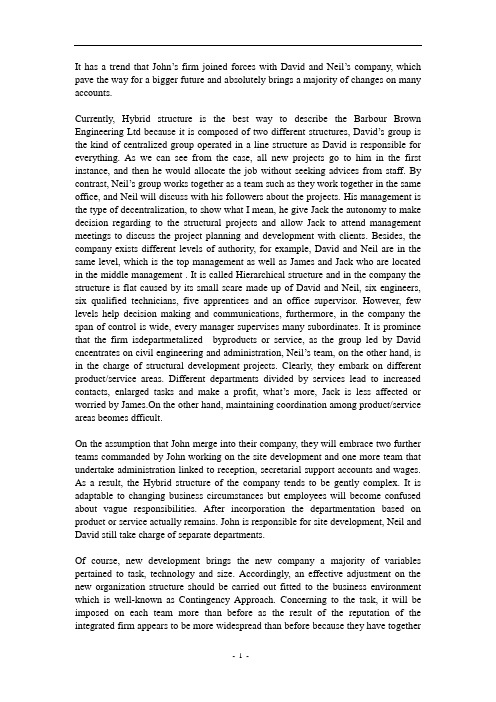
It has a trend that John’s firm joined forces with David and Neil’s company, which pave the way for a bigger future and absolutely brings a majority of changes on many accounts.Currently, Hybrid structure is the best way to describe the Barbour Brown Engineering Ltd because it is composed of two different structures, David’s group is the kind of centralized group operated in a line structure as David is responsible for everything. As we can see from the case, all new projects go to him in the first instance, and then he would allocate the job without seeking advices from staff. By contrast, Neil’s group works together as a team such as they work together in the same office, and Neil will discuss with his followers about the projects. His management is the type of decentralization, to show what I mean, he give Jack the autonomy to make decision regarding to the structural projects and allow Jack to attend management meetings to discuss the project planning and development with clients. Besides, the company exists different levels of authority, for example, David and Neil are in the same level, which is the top management as well as James and Jack who are located in the middle management . It is called Hierarchical structure and in the company the structure is flat caused by its small scare made up of David and Neil, six engineers, six qualified technicians, five apprentices and an office supervisor. However, few levels help decision making and communications, furthermore, in the company the span of control is wide, every manager supervises many subordinates. It is promince that the firm isdepartmetalized byproducts or service, as the group led by David cncentrates on civil engineering and administration, Neil’s team, on the other hand, is in the charge of structural development projects. Clearly, they embark on different product/service areas. Different departments divided by services lead to increased contacts, enlarged tasks and make a profit, what’s more, Jack is less affected or worried by James.On the other hand, maintaining coordination among product/service areas beomes dfficult.On the assumption that John merge into their company, they will embrace two further teams commanded by John working on the site development and one more team that undertake administration linked to reception, secretarial support accounts and wages. As a result, the Hybrid structure of the company tends to be gently complex. It is adaptable to changing business circumstances but employees will become confused about vague responsibilities. After incorporation the departmentation based on product or service actually remains. John is responsible for site development, Neil and David still take charge of separate departments.Of course, new development brings the new company a majority of variables pertained to task, technology and size. Accordingly, an effective adjustment on the new organization structure should be carried out fitted to the business environment which is well-known as Contingency Approach. Concerning to the task, it will be imposed on each team more than before as the result of the reputation of the integrated firm appears to be more widespread than before because they have togetheraccomplished many projects effectively with a high quality. Once the merge has come ture, David and Neil can take over more tasks working together with John’s teams and they are likely to be required to do more complicated tasks, so the link of each team become stronger leading the more complicated structure will be. John initially engages in the design job but he would take responsibility of both design and development of civil engineering and structural development projects. Neil is also placed in the similar situation, Neil acts as an liaison in the company. As a result, Neil is expected to consultant with clients much more times to provide the best service, on top of that, Neil bears more responsibilities to seek new projects, ensuring the company is stable, marketability, growing and becoming brighter. With regard to technology, John’s firm has not preferred to located in town centre any more result from new technology, computer networks and design communication with clients, therefore, it causes dispersion of department’s geographical location. Ultimately different locations will generate additional complicated structure for co-ordination. And furthermore it is imperative that David and Neil should absorb John’s worthful method of producing, which is also applicable to John’s team, in the end, they are expected to be in the harmony each other, the consequence of that is the complete approach tends to be slightly different. The size is considerably bigger than before when they create a merge. John has a large office coped with the additional staff from Barbour Brown and his equipment. Growing large contributes to redundancies, that is, more talented staff will not be fired and changes the company structure from organic to mechanistic and complex. John has the same status with David and Neil in the new structure. Obviously, the number of each levels within hierarchical structure should be increased.There are four categories of relationships involved in the mixed organization. First, Line relationship means the boss delivers the authority or command directly to their staff. For example, James gives out new projects to staff, which has a line relationship between James and the staff. If necessary, Neil passes the authority of decision making to Jack posing a line relationship, besides, the team leaders of site development will be commanded directly by John, meanwhile, the team leaders assign the work to subordinates. Next, the relationship between the assistants of senior staff and other staff is called Staff relationship. For instance, when David is absent from office, James will acts as a representative of him to authorize site visits, as a consequence, he has a staff relationship with other staff like Jack and civil engineers. The proposed new structure includes three independent apartments , in which functional specialist supports or has authority over certain activities of other particular department. It is defined as Functional relationship. To illustrate, the design specification of John’s team can cater fully for the civil and structure engineering projects, so they can offer assistants and supports for each other. What’s more, administration section manager have authority over other managers in secretarial support, wages and accounts. In the organization, Lateral relationship exist between staff at the same level. In the case, David, Neil and John are in the position, all of them are top managers who conducts their own section, in addition, both James andJack are the middle managers who manage the work of engineers and technicians. Authority, responsibility and delegation are the three types of relationships combined with the line relationship. Authority is the right to direct or guide the activities of others and select from their responses that are applicable to achieving the goals of the organization. As a general company policy, all new projects go to David at first, afterward, he would allocate the work to engineers and technicians. However, he never seek responses about the best method to divided up the work from them. Neil has the right to direct the structure work because David has little structure experience. In comparison with David, Neil normally discuss the projects with his team member. The merge of the two firms carries the benefit that engineers would have the formal authority to manage the construction staff because the bigger size the company is, the more formal ways of managing will be. As for responsibility, it is imposed on a person who has a certain position in an organization to complete a task , assignment or function. With the workload increasing, the leaders of each team confront a majority of responsibilities to turn out the projects, next, the detailed job operated by digger driver, qualified builder and technicians, sometimes, they will be ordered by top managers to work together to perform a heavy task. Turn to the last one, Delegation, which is the act of passing the responsibility to accomplish a task to another person. At that time, James is usually delegated to give out new projects to other staff and to promise site visits. This action successfully motivates James but irritate other engineers. In the future, David should be just, hence, he need to delegate this responsibility to the people who are deserved. It can remove dissatisfaction among organization. On the other hand, Jack is imparted the responsibility to make decision on the project’s progression with enough autonomy and flexibility, leading to Jack’s high enthusiasm and the high level performance of the department and that area is growing. A merge can help clarify the relationship of delegation that the design engineers are responsible for a given project on site. Unlike before, David’s rule of staff seeking permission for site visits is to be abolished after the incorporation., so that it tends to eliminate the resentment and improve the projects’efficiency and effectiveness.On the whole, the merge will lead to situational variables of tasks, technology and size, exerting an influence on the organization’s structure and may be on the methods of dividing and grouping activities together. More clearly the line, functional and lateral relationships combine individuals and different teams together to operate, the better relationship they have, the higher performance they will get. In order to perfect relationship between managers and followers, authority, responsibility and delegation should be completed well and appropriately.。
人力与组织管理outcome
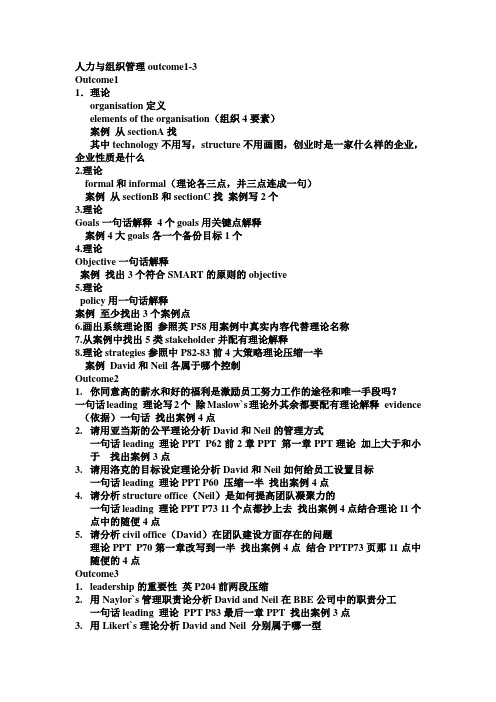
人力与组织管理outcome1-3Outcome11.理论organisation定义elements of the organisation(组织4要素)案例从sectionA找其中technology不用写,structure不用画图,创业时是一家什么样的企业,企业性质是什么2.理论formal和informal(理论各三点,并三点连成一句)案例从sectionB和sectionC找案例写2个3.理论Goals一句话解释4个goals用关键点解释案例4大goals各一个备份目标1个4.理论Objective一句话解释案例找出3个符合SMART的原则的objective5.理论policy用一句话解释案例至少找出3个案例点6.画出系统理论图参照英P58用案例中真实内容代替理论名称7.从案例中找出5类stakeholder并配有理论解释8.理论strategies参照中P82-83前4大策略理论压缩一半案例David和Neil各属于哪个控制Outcome21.你同意高的薪水和好的福利是激励员工努力工作的途径和唯一手段吗?一句话leading 理论写2个除Maslow`s理论外其余都要配有理论解释evidence (依据)一句话找出案例4点2.请用亚当斯的公平理论分析David和Neil的管理方式一句话leading 理论PPT P62前2章PPT 第一章PPT理论加上大于和小于找出案例3点3.请用洛克的目标设定理论分析David和Neil如何给员工设置目标一句话leading 理论PPT P60 压缩一半找出案例4点4.请分析structure office(Neil)是如何提高团队凝聚力的一句话leading 理论PPT P73 11个点都抄上去找出案例4点结合理论11个点中的随便4点5.请分析civil office(David)在团队建设方面存在的问题理论PPT P70第一章改写到一半找出案例4点结合PPTP73页那11点中随便的4点Outcome31.leadership的重要性英P204前两段压缩2.用Naylor`s管理职责论分析David and Neil在BBE公司中的职责分工一句话leading 理论PPT P83最后一章PPT 找出案例3点3.用Likert`s理论分析David and Neil 分别属于哪一型理论PPTP93页第一章案例David and Neil 属于哪一型分别各一点解释4.用Likert理论的KPI指数分析Neil的高效与David的低效理论PPTP92 第一章By前面一段抄下来案例各用一句话来说出Neil的高效与David的低效(一句话来自PPTP92 第二章第三章PPT )5.用Likert`s理论的KPI指数重要性分析在未来的管理中David and Neil因以什么为中心理论PPTP92 第一章By后面那段抄下来(注意By请用其他词来代替)案例分析David and Neil 各有什么不足之处(不从案例中找自己说)6.请用John Adair的理论帮助David提高工作绩效PPTP95 第三章PPT :之前summary(总结下) :之后照抄案例David有没有完成任务团队稳定么满足个人需求么7.用决策中心论帮助David更好的做决策理论PPTP97 第二章~第三章\压缩其中写出(理论名称理论作用理论内容)案例用PPTP98 第一章、第二章中的点来写出David 如何更好的做决策(3点)比例可以是第一章:第二章=1:2(点)或者第一章:第二章=2:1(点)8.请用情景理论分析Neil用过的两种情景理论PPTP100前二章PPT S1 S2 S3 S4 用关键点解释其中写出(理论名称理论作用理论内容)案例Neil用过的2个两种情景(成熟度与准备度相匹配)9.英P238 最后一段整一个Outcome3 压缩。
人力资源管理和组织管理

如何应对未来的趋势和挑战
增强适应能力:面对快速变 化的环境,组织需要不断学 习和适应
培养人才:关注员工培训和 发展,提高员工的技能和知 识水平
创新管理:采用灵活的管理 模式,鼓励员工创新和尝试
关注社会责任:注重企业社 会责任,关注社会和环境问 题,树立良好的企业形象
加强合作:与外部合作伙伴 建立紧密的合作关系,共同 应对挑战
组织管理的新挑战
数字化转型:随着技术的发展,组织需要适应数字化趋势,调整管理方式。
人才管理:如何吸引、培养和留住优秀人才是组织管理的关键挑战。 多元化和包容性:组织需要应对多元化的员工队伍,并确保包容性,以实现公平和高效的 组织。
灵活性和适应性:组织需要具备灵活性和适应性,以应对快速变化的市场环境。
人力资源管理和 组织管理
a click to unlimited possibilities
汇报人:
人力资源管理 的定义和重要 性
组织管理的基 本概念和原则
人力资源管理 流程和策略
组织结构设计 和优化
人力资源管理 与组织管理的 关系及挑战
未来趋势和挑 战
人力资源管理的定义和 重要性
人力资源管理的定义
质量
招聘策略:通 过多种渠道发 布招聘信息, 如招聘网站、 社交媒体、招
聘会等
选拔策略:采 用多种选拔方 法,如面试、 笔试、技能测 试等,以评估 候选人的能力
和潜力
培训需求分析
培训与发展
培训计划制定
培训实施与控制
培训效果评估与反馈
绩效管理
定义:绩效管理是指通过制定目标、评估和反馈等方式,对员工的工作表现进行管理和 提升的过程。
诚度
组织管理的基本概念和 原则
hnd_人力组织与管理_outcome13_全部答案
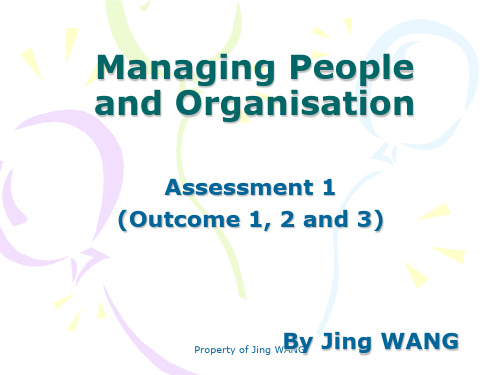
satisfy customer’sPropneretyeofdJing WANG
Section A
2b. Objectives and policies
-- product goals: to provide the best designs through well trained staff; to provide high quality service
-- operational goals: to know what work is being carried out and whereabouts of staff at any given time; use local contractors for development
-- Based on explicit values
• Policies in case:
-- all work should be allocated by David
-- David required the staffs to use timesheet
-- use local firms to provide service, such as local contractors, insurance brokers and accountants
-- secondary goals: use local contractors, insurance brokers and accountants for services to the company
人力资源团队管理 解码HR行业团队管理之道

人力资源团队管理解码HR行业团队管理之道人力资源团队管理:解码HR行业团队管理之道人力资源(Human Resources,简称HR)团队管理是组织成功的关键要素之一。
随着企业的发展和竞争日益激烈,如何高效管理HR团队成为了领导者们面临的挑战。
本文将探讨几个关键方面,解码HR行业团队管理之道,以帮助企业更好地管理和发展人力资源团队。
一、目标设定与规划良好的目标设定是HR团队管理的核心。
团队成员需要清楚明确地知道他们的工作目标,以及如何与组织整体目标相连接。
同时,HR团队管理需要合理规划资源,确保所需的人力、物力和财力得到充分的保障。
为了实现目标设定和规划,HR团队需要深入了解企业的战略方向和发展需求。
只有了解公司的整体目标,HR团队才能更好地提供支持和解决方案,为企业的成功做出贡献。
二、组建与培养团队HR团队的构建和培养是HR团队管理的重要环节。
在招聘新成员时,HR团队需要明确岗位需求,透过面试和评估,选择适合的人才。
在这个过程中,HR团队应注重关注团队成员的专业素质、团队合作能力和个人发展潜力。
为了培养团队成员的综合能力,HR团队应制定培训计划和发展计划,提供培训和学习的机会。
此外,团队成员之间的知识共享和经验交流也是重要的,HR团队应该积极促进这种交流,以进一步提升团队整体水平。
三、有效沟通与协作良好的沟通和协作是HR团队管理成功的基石。
HR团队需要与各个层级的员工保持密切联系,了解员工的需求和问题,并及时有效地提供解决方案。
团队成员之间也需要相互协作,共同完成任务和项目。
在沟通方面,HR团队应当遵循及时、准确和透明的原则。
及时沟通能够让员工感受到团队的关注和支持,准确沟通能够避免信息失真和误解,透明沟通能够建立起信任和共识。
四、激励与激发团队潜力激励团队成员发挥潜力是HR团队管理的一项重要职责。
HR团队应与员工建立稳定的关系,在工作中不断激发员工的潜力和创造力,鼓励他们超越自己,实现自身价值。
组织与人事管理

PPT文档演模板
组织与人事管理
資料查證
n 對應徵者提供之資料要有事先之查證,特 別是證書(美國大學每年查詢電話中有超過 10%是不實)、執照、推薦函等。
n 此外過去之工作資歷也是查證之重點;甚 至因此而查出個人之信用情況、負債情形、 聲譽、個性、能力及生活方式等,這對組 織言,都是極具參考價值之人事資料。
所需。 n 就一般言,專業知識測驗室較不會引起歧
視問題或爭議的甄選工具。
PPT文档演模板
组织与人事管理
心理測驗
n 有些時工作職位,除專業知識外(或許程度上只需 基礎級即可)所需是某種心理上之特質,如護士需 要相當愛心與耐心,銷售員需要相當之親切感。
n 心理測驗有助公司找到更好之員工 n 心理測驗是高度專業化之工作,通常委外實施。 n 人格構面之五項因素:包括外向、情緒穩定性、
3rew
演讲完毕,谢谢听讲!
再见,see you again
PPT文档演模板
2020/11/30
组织与人事管理
親切、擇善固執和開放心胸;與工作績效與訓練 績效相關研究。
PPT文档演模板
组织与人事管理
心理測試之人格構面相關性 (對工作能力與學習能力之績效)
職務 專業 警官 管理 銷售 技術 半技 說明
績效 人士
者 人員 工人 術工
外向 X
情緒 ? 穩定 親切 ?
擇善 Y 固執 開放 X 心胸
PPT文档演模板
n 系統化之全程風險管理
PPT文档演模板
组织与人事管理
家族化管理與職業化管理比較
n 家族式管理多半在創業之初期,規模不大。 n 職業化管理用於企業有一定之規模與成熟
人力资源管理学入门知识组织管理和员工关系的基本概念

人力资源管理学入门知识组织管理和员工关系的基本概念人力资源管理学入门知识人力资源管理(Human Resource Management,简称HRM)是指组织和管理人力资源,以实现组织目标和个体发展的一门学科。
它是一门综合性的学科,在实践中涉及组织管理、员工关系、招聘、培训、绩效评估等多个方面。
其中,组织管理和员工关系是人力资源管理学的基本概念之一。
一、组织管理组织管理是人力资源管理的重要组成部分,它涉及到组织的设计、结构、沟通、决策等方面。
在组织管理中,有几个基本概念需要了解。
1. 组织结构组织结构是指组织中各个部门、职位之间的相互关系和层次结构。
常见的组织结构包括分工结构、职能结构、矩阵结构等。
合理的组织结构能够提高组织的效率和灵活性。
2. 组织设计组织设计是指根据组织目标和要求,制定适合的组织结构和工作流程。
在组织设计中,需要考虑到组织的规模、层次、职权划分等因素,以实现组织的目标。
3. 组织沟通组织沟通是指组织内部成员之间的信息交流和沟通。
有效的组织沟通可以促进信息流通,增强工作效率和团队合作。
4. 组织决策组织决策是指在组织中制定和执行决策的过程。
良好的组织决策可以保证组织的正常运转和发展。
二、员工关系员工关系是指组织与员工之间的相互关系和互动。
在人力资源管理中,良好的员工关系能够提高员工工作满意度和组织绩效。
以下是与员工关系相关的基本概念。
1. 雇佣关系雇佣关系是指组织与员工之间的雇佣合同关系。
组织应该遵守相关法律法规,确保雇佣关系合法、公平。
2. 员工福利员工福利是指组织提供给员工的各类福利待遇。
员工福利可以包括社会保险、健康保险、带薪休假等。
3. 员工参与员工参与是指员工在组织决策和管理中的参与程度。
组织应该鼓励员工参与,提高员工的归属感和主动性。
4. 员工满意度员工满意度是衡量员工对组织的满意程度。
组织应该关注员工的需求和期望,提高员工的工作满意度。
总结:人力资源管理学中的组织管理和员工关系是基本概念,对于组织和个体的发展都具有重要意义。
hnd_人力组织与管理_outcome1-3_全部答案(课堂PPT)

satisfy customer’s need
6
Section A
2b. Objectives and policies
• Definition of policy
-- Provide a framework of rules or guidance that manager and staff can make decision
• Facility, technology, financial (bank loan, gran3t)
Section A
2a. Four main goals
• Goal Description -- Determine the direction of organisation -- Define and set clear targets -- Help organisations identify: What, How,
-- secondary goals: use local contractors, insurance brokers and accountants for services to the company
5
Section A
2b. Objectives and policies
• Definition of objective
• Words requirement: 1,500 words
• Time length: 135 minutes
• A4 page of note is allowed to bring with candidates
• Candidates should achieve at least 50% to pass
hnd_人力组织与管理_outcome1-3-文档资料
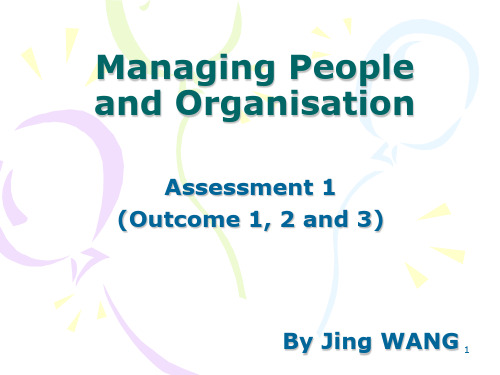
• Each section is 30 marks
2
Section A
1. Basic components of organisation
• People
-- managerial staff -- qualified engineer -- technicians -- apprentice
• Words requirement: 1,500 words
• Time length: 135 minutes
• A4 page of note is allowed to bring with candidates
• Candidates should achieve at least 50% to pass
-- secondary goals: use local contractors, insurance brokers and accountants for services to the company
5
Section A
2b. Objectives and policies
• Definition of objective
visit
7
Section A
3. How organisation interacts with external environments
Inputs
• Well trained staff
• Loan from bank, grant
• Equipments • Local
contractors, insurance brokers and accountants
Managing People and Organisation
hnd人力组织与管理组织outcome3全部答案解析

-- operational goals: to know what work is being carried out and whereabouts of staff at any given time; use local contractors for development
• Objectives
-- concentrate on civil engineering business -- provide a high quality service
• Structure
-- Civil engineering project -- Structural engineering project
Property of Jing WANG
Section B
6. Motivation for staff depends on more than high salary and working condition
Explaining one of the following theories: • Maslow’s hierarchy of need • Herzberg’s two factor theory • Alderfer’s ERG theory
• Well trained staff
• Loan from bank, grant
• Equipments • Local
contractors, insurance brokers and accountants
hnd人力组织与管理outcome全部答案
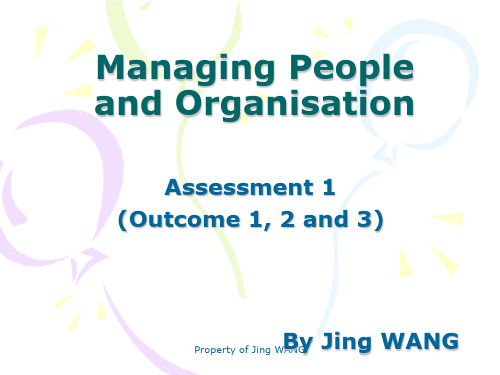
Property of Jing WANG
Section B
6. Motivation for staff depends on more than high salary and working condition
Explaining one of the following theories: • Maslow’s hierarchy of need • Herzberg’s two factor theory • Alderfer’s ERG theory
Property of Jing WANG
Section B
6. Motivation for staff depends on more than high salary and working condition
• David used ‘Big Brother’ approach, which means it has complete control over people and is always checking what they do, he liked to run a tight ship
人力资源 outcome1 考试评分要求及标准答案 by小凡
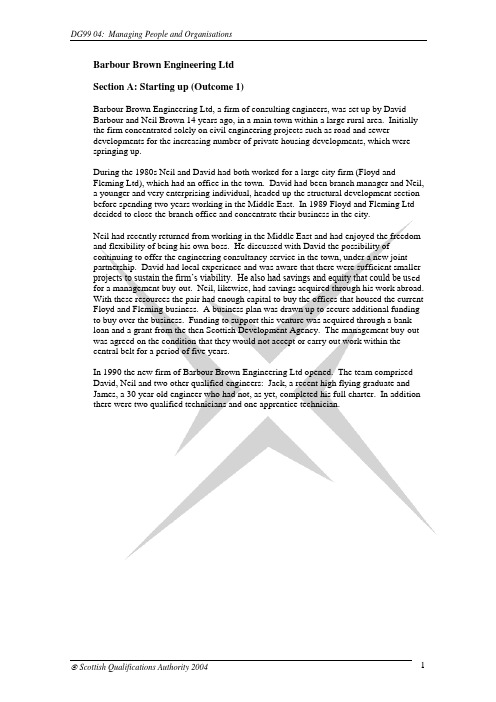
Barbour Brown Engineering LtdSection A: Starting up (Outcome 1)Barbour Brown Engineering Ltd, a firm of consulting engineers, was set up by David Barbour and Neil Brown 14 years ago, in a main town within a large rural area. Initially the firm concentrated solely on civil engineering projects such as road and sewer developments for the increasing number of private housing developments, which were springing up.During the 1980s Neil and David had both worked for a large city firm (Floyd and Fleming Ltd), which had an office in the town. David had been branch manager and Neil, a younger and very enterprising individual, headed up the structural development section before spending two years working in the Middle East. In 1989 Floyd and Fleming Ltd decided to close the branch office and concentrate their business in the city.Neil had recently returned from working in the Middle East and had enjoyed the freedom and flexibility of being his own boss. He discussed with David the possibility of continuing to offer the engineering consultancy service in the town, under a new joint partnership. David had local experience and was aware that there were sufficient smaller projects to sustain the firm’s viability. He also had savings and equity that could be us ed for a management buy-out. Neil, likewise, had savings acquired through his work abroad. With these resources the pair had enough capital to buy the offices that housed the current Floyd and Fleming business. A business plan was drawn up to secure additional funding to buy over the business. Funding to support this venture was acquired through a bank loan and a grant from the then Scottish Development Agency. The management buy-out was agreed on the condition that they would not accept or carry out work within the central belt for a period of five years.In 1990 the new firm of Barbour Brown Engineering Ltd opened. The team comprised David, Neil and two other qualified engineers: Jack, a recent high flying graduate and James, a 30 year old engineer who had not, as yet, completed his full charter. In addition there were two qualified technicians and one apprentice technician.Assessment task 1Section A (Outcome 1)1.With reference to the firm in the case study, describe the basic components of a workorganisation.2.a Using a recognised classification, explain the importance of the four maingoals of the organisation in the case study.b Identify examples of objectives and policy from the case study and commenton how effectively you believe they have been implemented.ing an open systems diagram, describe how the organisation in the case studyinteracts with its external environment.4.All organisations have stakeholders. Give examples of the main stakeholders of thisorganisation giving reasons for your answer. You should identify at least fourstakeholders.5.Outline four strategies for controlling staff. Identify the one used by David Barbour.Assessment ChecklistsAssessment task 1Section A (Outcome 1)1.The basic components of a work organisation.First, organisations are made up by people. They have purposes, they use resources-human and non-human to achieve their purposes. They perform activities in a planned and controlled manner. For example, David and Neil who ran their company that employed two qualified engineers, two qualified technicians and one apprentice technician for the new firm of them. Neil and David were employed by a large city firm during the 1980s.Second, organisations have their own goals. Goals of organisations operating in the private sector generally revolve around the maximisation of profits for the owners. However, some organisations also have other objectives that they may purpose in the short term. For instance, Neil discussed with David the possibility of continuing to offer the engineering consultancy service in the town. Plans that apply to the entire organisation, that establish the organisation’s overall objectives. A new business plan was drawn up for their new engineering consultancy service in the town, which could be found in the text.Finally, the most important factor is the “framework” of the organisations. It affects the organisation to achieving the goals. The internal and external environments of the organisation have an effect on the organization structure. Evidenced by, Neil and David designed civil and engineering structures. They firstly want to continue to offer the engineering consultancy service in the town and then accumulated the savings and equity. With these resources the pair had enough capital to buy the offices and eventually drawn up a business plan to secure additional funding to buy over the business. They structured the engineering designs for employing different people to effectively manage the staffs.2.a. Goals help the organisations to identify who is the person to set up the goals, whatis the content of the goals, when is the goals to carry out, how is the goals to achieve, why the goals should be realized. This case study should provide a specific objective to achieve and assess for the firm. It lacks of these information. They are 4 main goals the organisations.1)Operational goals, which cover areas such as staffing levels or technology to beused. It is better to design a plan for manage the staff, such as, they can controltheir whereabouts at any time and check their working conditions. They willensure that any investments we make are environmentally sound, so theycould have an agreement with the local contractors for development.2)Product goals, it ignores people because it concerns more about the product.Therefore, using the effective approaches becomes the key point for trainingwell the staffs. In this way, people devote themselves to working and the bestdesigns will be created.3)Consumer goals. Providing high quality service and maintain a suitable priceare to be considered by Barbour Brown Engineering Ltd. In this way, consumer will purchase product with satisfaction and continue to buy. It is benefit forboth the consumers and the engineering company.4) Secondary goals. As we know, secondary goals are not the most importantthings that they would like to achieve but nevertheless important. Sometimessecondary goals can include making a profit, after the more important goal ofsurvival.b. ObjectivesBecause the new firm of Barbour Brown Engineering Ltd has been opened, objectives should be effectively carried out. First, they must ensure that staffs are well trained, for example, engineers, technicians and apprentice technician in the new firm have to be trained. Second, every personnel must complete works punctually. Work efficiency will be improved by restricting time of theirs. A track of ongoing products is to be kept if the company has to develop rapidly and steadily. A useful timesheets can make the project clearly and systematically.PolicyThese provide a framework of rules and guidance within which management and staff can make decisions. They may be based on explicitly stated values. First, the staffs and managers should be complete the timesheets in common. Second, one of the policies to train the staffs is using local training providers. Third, policies generally reflect the values of the major stakeholders. All works can be allotted by David or Neil. Finally, if the financial apartment needs to invoice, then their invoice work at quoted price.3.Input- Process-A.Get help from clients during work A. Liaison between clientsB.Get capital from bank B. Arrangement of projectsC.Have the staffs qualified C. Assistance of AdministrationOutput-A. Satisfy the clientsB. Train the staffC. Produce the designs1) Political Factors: Bank suddenly increases the price of credits. So if they get a lot of money from bank, it is maybe hard to pay back and limit the development of this firm.2) Social Factors: If the educational level of this area is limited the staffs that are qualified of this kind of job will be deficient.3) Economic Factors: If the quantity of client in demand is large, it exist competition about the costs of engaging clients.4) Technology: If the firm don’t improve the production efficiency in accordance with the original method. Other competitors will catch up with the firm or overtake. Consequently, it is necessary to use the automated production.5) Potential future scenarios: Interests rate maybe rise from year to year. It will have an effect on circulating capital.6) Environment: Large number of designs during production may result in the pollution. Perhaps sound of complains destroy the image of the firm. Such as, people doubt if the designs are good for their health.4.Main stakeholders:1) EmployeesEmployees are primarily interested in job security. This group is a vital resource of the organisation and, as such, without their continued efforts, the organisation would not be able to survive. They contribute to the wealth of the organisation and are keys to its success. For example, allocate position effectively, efficient training, satisfactory income.2) Suppliers (engineering contractors)Suppliers, similar to customers, are likely to wish to maintain a good relationship with the organisation since there may be a monetary reward involved. For instance, offer jobs for them, make a good agreement in corporate benefits.3) ClientsAlthough it is not included in the major stakeholders, clients deal with some procedures for architects. Offering a kind of service for them could achieve corporate objectives. 4) Finance providersFinanciers look at an organisation as a potential money-earning instrument. For example, large banks, they are unlikely to invest if they do not think that there will be any financial gain or reward for themselves. Therefore, it is a good way to add source of income by increasing interest charges.5) Train providersProviders are more care about their jobs, especially their income. For one thing, the firm trains the providers with purpose, the efficiency of work will enhance. For another, providers are interested in their jobs; they dedicate themselves to their work seriously.5.In order for the organisation to reach its goals. It is normally necessary for someform of control to be used to regulate what is done on a day-to-day basis.Organisation control is the imposition of processes, procedures and standards upon an operation in terms of machinery or personal interactions. In ensuring that controls are maintained an organisation’s leaders will set and monitor standards, introduce plans and strategies, measure actual performance and take correct actions.1)Bureaucratic control. For example, David and Neil check and monitor theefficiency of the branch manager periodically, and the branch managers makeplans and finish the objectives of plans. Meanwhile, branch manager shouldalso inspect and supervise the staffs of their work unexpectedly. Although, itmaybe will bring great pressure to everyone, it can make the bureaucraticcontrol efficiently.2)Control the output. For example, the organisation can delegate supervisors tomonitor workers in the factory. Poor quality of the outputs can reproduce orthrow them away. The supervisors check machines or facilities before there aresome problems. Supervisors write reports periodically to organisation todescribe troubles of the factory.3)Personal centralised. It is the responsibility of David. He is the primaryshareholder of the new firm. He has to monitor engineers, technicians, etc. Ifthere are some troubles in technical of his subordinates, he must take charge ofall problems. Therefore, he can make plans about the future development of hisfirm and control through rewards and punishments.4)Cultural control. If the company makes large profit at the end of the year,holding a party to celebrate is a good choice. But if there are some staffs who are the Muslims, they should pay much attention about the food, such as, the Muslims don’t eat pork.。
人力与组织管理
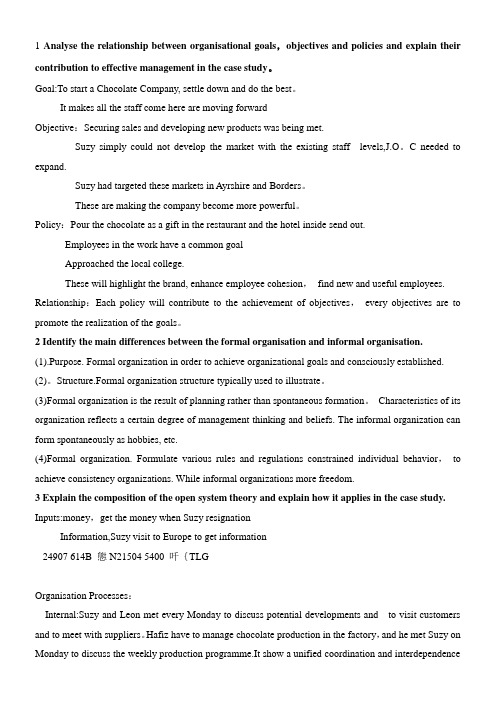
1 Analyse the relationship between organisational goals,objectives and policies and explain their contribution to effective management in the case study。
Goal:To start a Chocolate Company, settle down and do the best。
It makes all the staff come here are moving forwardObjective:Securing sales and developing new products was being met.Suzy simply could not develop the market with the existing staff levels,J.O。
C needed to expand.Suzy had targeted these markets in Ayrshire and Borders。
These are making the company become more powerful。
Policy:Pour the chocolate as a gift in the restaurant and the hotel inside send out.Employees in the work have a common goalApproached the local college.These will highlight the brand, enhance employee cohesion,find new and useful employees. Relationship:Each policy will contribute to the achievement of objectives,every objectives are to promote the realization of the goals。
人力资源与组织变革管理的关系
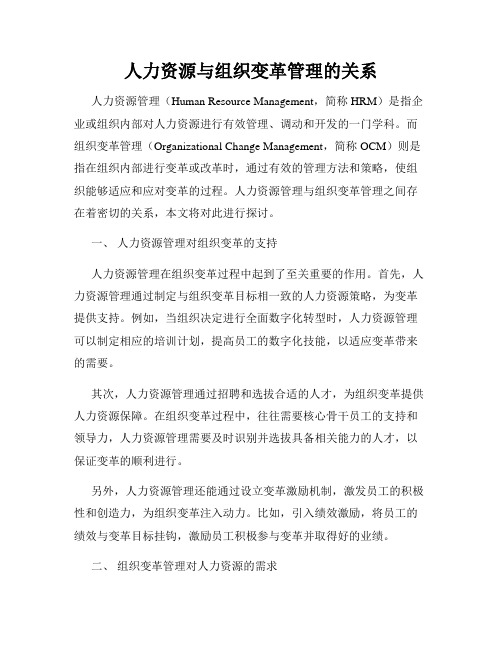
人力资源与组织变革管理的关系人力资源管理(Human Resource Management,简称HRM)是指企业或组织内部对人力资源进行有效管理、调动和开发的一门学科。
而组织变革管理(Organizational Change Management,简称OCM)则是指在组织内部进行变革或改革时,通过有效的管理方法和策略,使组织能够适应和应对变革的过程。
人力资源管理与组织变革管理之间存在着密切的关系,本文将对此进行探讨。
一、人力资源管理对组织变革的支持人力资源管理在组织变革过程中起到了至关重要的作用。
首先,人力资源管理通过制定与组织变革目标相一致的人力资源策略,为变革提供支持。
例如,当组织决定进行全面数字化转型时,人力资源管理可以制定相应的培训计划,提高员工的数字化技能,以适应变革带来的需要。
其次,人力资源管理通过招聘和选拔合适的人才,为组织变革提供人力资源保障。
在组织变革过程中,往往需要核心骨干员工的支持和领导力,人力资源管理需要及时识别并选拔具备相关能力的人才,以保证变革的顺利进行。
另外,人力资源管理还能通过设立变革激励机制,激发员工的积极性和创造力,为组织变革注入动力。
比如,引入绩效激励,将员工的绩效与变革目标挂钩,激励员工积极参与变革并取得好的业绩。
二、组织变革管理对人力资源的需求组织变革管理对人力资源的需求也不容忽视。
首先,组织变革往往需要大量的信息沟通和培训工作,这就需要人力资源管理提供相关的培训和发展计划,提升员工的变革敏感性和应变能力。
其次,组织变革的过程中,可能会发生部分员工的离职和重新定位,这就需要人力资源管理进行组织的人员调配和离职安置,以确保组织变革的目标能够得到有效地实现。
另外,组织变革管理还需要人力资源部门提供专业的支持和咨询,帮助管理层进行变革方案的制定和实施。
人力资源管理部门应对变革进行分析和评估,提供相关的建议和意见,帮助组织顺利实施变革。
三、人力资源与组织变革管理的协同作用人力资源管理与组织变革管理之间并非是单向的影响关系,而是一种相互促进、协同作用的关系。
- 1、下载文档前请自行甄别文档内容的完整性,平台不提供额外的编辑、内容补充、找答案等附加服务。
- 2、"仅部分预览"的文档,不可在线预览部分如存在完整性等问题,可反馈申请退款(可完整预览的文档不适用该条件!)。
- 3、如文档侵犯您的权益,请联系客服反馈,我们会尽快为您处理(人工客服工作时间:9:00-18:30)。
Getting the correct balance between each of these 3 rules is the key to the success of the organisational structure. The way that organisations take shape can be affected by many considerations, such as specialisation of personnel, known as the 2013-1-9 Managing division of labour.People and Organizations
2013-1-9
Managing People and Organizations
18
Classification of Organisations
11
Specialization特殊性
It occurs when organizations or individual workers concentrate on a limited type of activity The advantage of arranging work in this way lies in the following facts:
6
Why Organizations Exist
They satisfy social needs They are more efficient at fulfilling needs than individuals They save time They pool knowledge They are power centres
Outcome 1
Explain the Nature of Organisations
2013-1-9 Managing People and Organizations 1
What Is An Organization
The term can be used broadly in two ways: It can refer to a group or institution arranged for efficient work.
15
The Elements of the Informal Organisation
Although the informal organisation is not directly seen as a structural element, it is in fact remarkably powerful in terms of influencing behaviours and attitudes towards the work environment. In some organisations the informal element may be the powerhouse of performance and achievement.
2013-1-9
Managing People and Organizations
4
Basic Components of Organisations
People Objective Structure
2013-1-9
Managing People and Organizations
5
Organizational Resouhe Elements of the Formal Organisation
A formal organization is one that has a conspicuously coordinated system of human interactions with a common purpose A formally structured organisation is one where the reporting structure is defined. There may be written procedures providing formal support to the structure covering rules for behaviour and such areas as grievance and discipline.
The Elements of the Informal Organisation
An informal organization is one that has social interactions without a conspicuous structure or common purpose Within a formal organization, an informal organization is likely to be present These groups meet social needs of workers, providing a sense of camaraderie, but they are not part of the formal organisation and are not included by management in an organisational 2013-1-9 Managing People and Organizations chart.
2013-1-9 Managing People and Organizations 10
The Elements of the Formal Organisation
Some rules of organisational structures :
span of control levels of management delegation
“A group of people engaged in a joint enterprise. ”
It can also refer to a process.
“An arrangement for achieving controlled performance in pursuit of collective goals.”
Large – over 2000 employees medium – between 50 and 2000 employees Small – below 50 employees
Volume of output Volume of sales Assets employed Profits earned Net worth in real term
2013-1-9
Managing People and Organizations
3
Characteristic of Organizations
Organisations are made up at least 2 people. They have purposes. They use resources – human and non-human- to achieve the purposes. They perform activities in a planned and controlled manner.
2013-1-9 Managing People and Organizations 2
Definition
An organization is a group of individuals operating together in a systematic way to achieve a set of objectives
Environment
Raw materials Machinery Human resources Money Information
Inputs
Organization process
Goods or service
Outputs
2013-1-9
Managing People and Organizations
2013-1-9
Managing People and Organizations
17
Classification of Organisations
Classification by Purpose: Economic – e.g. businesses Protective –e.g. armies, police, prisons, trade unions Associative – e.g. clubs Public Service –e.g. local council or hospitals Religious – e.g. churches
2013-1-9 Managing People and Organizations 8
Classification of Organisations
Classification by Structure : Formal Informal
2013-1-9
Managing People and Organizations
Encourage the use of highly specific equipment Semi-skilled labour can be employed Workers are able to develop a high level of expertise
2013-1-9 Managing People and Organizations 13
2013-1-9 Managing People and Organizations 16
Classification of Organisations
